Lady Esther
Documents from a 1943 court case suggest that Lady Esther was started by Syma Busiel selling Lady Esther cream and powder house-to-house in Chicago in 1913 (Lady Esther, Ltd. v. Lady Esther Corset Shoppe, 1943). Outlets for her products were later opened in drug stores in Chicago and the surrounding area with department stores following on.
However, rather than being the work of one woman, the development of Lady Esther appears to have included a number of Syma’s immediate and extended family. Office holders in the company, at one time or another, included David Z. Hamburg, the husband of Syma’s sister, Florence Cohen [1899-1998], and two of Syma’s brothers, Alfred Hamilton Busiel and Otto Cohen [1888-1979]. Other members of the family were also involved in the business.
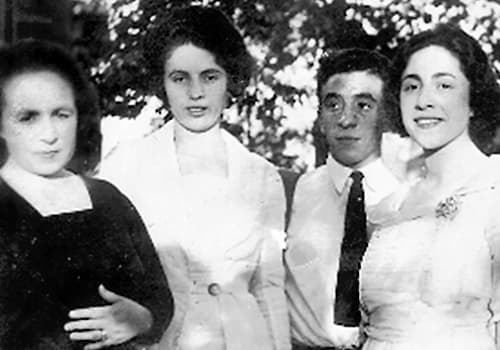
Above: c. 1917 From left to right: Esther [b.1885], Syma [b.1891], Alfred [b.1901] and Florence [b.1900] Cohen-Busiel. Some members of the family used their father’s surname (Cohen) while others used their mother’s maiden name (Busiel). Syma used both at different times.
The first president of Lady Esther was Otto Cohen. When he sold his stake in Lady Esther in 1925 his position as president was taken over by Syma. Alfred became the company’s third president when he bought Syma’s share of the business after the Second World War.
1920s
By 1920, the company was on a firm footing and Syma applied to have Lady Esther trademarked in the United States. One of the Cohen siblings was named Esther but it seems more likely that the company name was referencing Esther from the Book of Esther, described as a great beauty.
In 1921, to expand the business, Lady Esther hired Collins-Kirk, a Chicago advertising agency, to conduct a national advertising campaign. A distributor – J. S. O’Callaghan & Son, San Francisco, California – was also engaged to shipLady Esther products on the West Coast. By 1923, with rising sales, Lady Esther was doing well and the company moved from 441 West Division Street, Chicago, to larger facilities at 5710 Armitage Avenue.
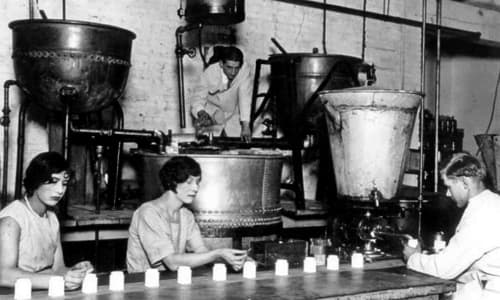
Above: c.1925 Assembly line for Lady Esther Four-Purpose Cream. The man at the back is mixing the oil and water parts of the cream. This is being dispensed by the man on the right into white glass jars which then pass along the assembly line.
Products
When Lady Esther incorporated in 1922, with a capital stock of US$400,000, it had a wide range of toilet goods for sale including face creams (greaseless, massaging and whitening), talcum powder, face powders (loose and compact), lipsticks, rouges (cream and compact), soaps and toilet waters.
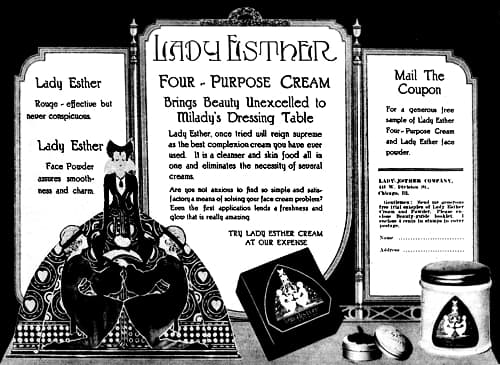
Above: 1921 Lady Esther Four-Purpose Cream, Face Powder and Rouge.
The most important of these products was the Lady Esther Four-Purpose Cream, an all-purpose cream that could act as a skin cleanser, skin food, astringent, and powder base. Modern versions were made from mineral oil, water, beeswax, cetyl esters, sodium borate, and magnesium aluminum silicate which suggest the Four-Purpose Cream was a type of cold cream. The earliest references I have for it date from 1921, when it replaces earlier mentions of massaging and greaseless creams but not the Lady Esther Whitener Cream.
Four-Purpose Cream: “Lady Esther Cream is an aid in removing pimples, sallowness and wrinkles. The cream that cleanses the skin thoroughly, refines the pores and obviates the necessity for an astringent or vanishing cream. Also an excellent base for powder.”
See also: Cold Creams and All-Purpose Creams
Like other cosmetic companies of the time, clogged pores leading to reduced ‘skin breathing’ was a favourite topic used by Lady Esther to promote the Four-Purpose Cream and the company would return to the subject of clogged pores many times in the following years.
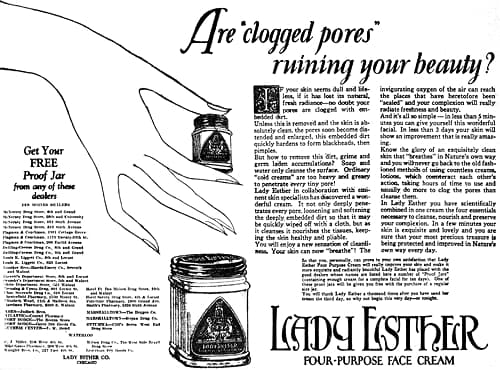
Above: 1927 Lady Esther Four-Purpose Cream.
One cream on your dressing table in which is scientifically combined the four essentials necessary to cleanse, nourish and preserve your most precious treasure—your complexion. It not only deeply penetrates every pore, loosening and softening the deeply embedded dirt so that it can be quickly wiped off with a cloth, but as it cleanses it nourishes the tissues, keeping the skin healthy and pliable.
You will enjoy a new sensation of cleanliness. Your skin can now “breathe”? The invigorating oxygen of the air can now reach places that have heretofore been “sealed” and your complexion will really radiate freshness and beauty.
And its all so simple—in less than 5 minutes you can give yourself this wonderful facial. In less than 3 days your skin will show n improvement that is really amazing.
Know the glory of an exquisitely clear skin that “breathes” in Nature’s own way! You will then never go back to the old fashioned methods of using countless creams lotions etc., which usually counteract each other’s action taking hours of time to use and usually do more to clog the pores than cleanse them.(Lady Ester advertisement, 1928)
Also see: Skin Breathing
The four functions of the cream – cleanser, skin food, astringent, and powder base – underwent some alterations through the years. By 1929, they had been changed to cleanser, skin softener, skin strengthener and powder base and, in more recent times, it was promoted as a cleanser, skin softener and make-up base.
A second product of importance was Lady Esther Face Powder. Qualitative tests competed in 1934 suggest that it was made with a talc-stearate-zinc oxide base with a little added chalk along with perfume and colouring. More recent versions list the following ingredients: talc, kaolin, zinc stearate, calcium carbonate, zinc oxide, titanium dioxide, mineral oil, sodium dehydroacetate, methylparaben, propylparaben, and trisodium EDTA. Leaving aside the last four ingredients, which are preservatives and chelating agents, not much appears to have changed.
Face Powder: “An elusive, soft powder that is a marked aid in reducing large pores. Gives a perfectly natural effect.” Shades: White, Brunette, and Flesh.
A second Frenchy Face Powder was added in 1923, perfumed with a fragrance from Carnay Parfumee in Paris. I can find no reference to a French perfume house called Carnay but note that the same house was also credited with providing the fragrances for some of the Lady Esther Toilet Waters – Frenchy, Chypre, Poppi, and Origame – discontinued in 1925. Like many American fragrances sold during this time, the French-sounding names may have been used to create the illusion that they were from France rather than being produced locally.
The 1930s
The stock market crash of 1929 ushered in the Great Depression of the 1930s. Money was tight and to raise additional revenue the American Federal Government passed Revenue Act in June, 1932 which raised the U.S. corporate tax rate by almost 15 per cent.
Lady Esther attempted to minimise the amount of tax it would pay under the Act by creating a series of companies that would sell to each other. Consequently, in November, 1932, Lady Esther, Inc. was renamed as Lady Esther Ltd. and Cosmetics, Inc. was created as the company’s ‘manufacturer’. In 1934, an additional company was founded, Packaging, Inc. to ‘package’ Lady Esther products. However, the officers and stock owners of each of the three companies were the same and none of the company’s production processes altered so this was simply an accounting change. Needless to say, the American Internal Revenue Service (IRS) contested this tax minimisation strategy and successfully took Lady Esther and other companies that tried this strategy to court.
See also: Bourjois (post 1930)
Overseas markets
In 1922, after entering into a very short-lived marriage, Syma went to Canada, applied for a Canadian trademark for Lady Esther in June, and secured an agent to distribute Lady Esther products there. In 1923, Lady Esther was also trademarked n Britain but the company failed to secure a distribution agent. Some overseas outlets were developed later on. Two that I know of were The Philippines and Australia. Lady Esther products became available in both of these countries in the early 1930s and remained on sale until supplies were cut off during the Second World War.
Radio
In 1931, through its advertising agency, Stack-Goble, Lady Esther secured the services of Wayne King and his orchestra and began advertising on radio. Lady Esther sponsored two Wayne King radio programs, ‘Wayne King and orchestra’ on the National Broadcasting Company (NBC) network and the ‘Lady Esther Serenade’ on the Columbia Broadcasting System (CBS). In their hay-day both programs ran twice weekly. Unusually for the time, the Lady Esther promotions were done by a woman, mostly by Bess Johnson who was the ‘voice of Lady Esther’ for six years.
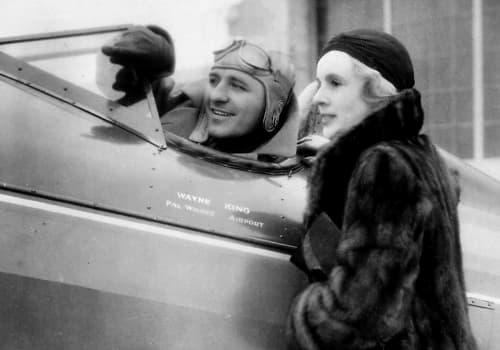
Above: 1934 This photograph is generally assumed to be of Wayne King [1901-1985] and Syma Esther. However, the woman in the photograph may be the actress Bess Johnson [1901-1975] who impersonated Lady Esther with an English accent during the radio broadcasts.
By September, 1932, largely due to radio advertising, Lady Esther’s business had increased by about 400% (‘Broadcasting,’ February 15, 1933, p. 10) and the company’s share of the American face powder market went from 1% to 17% by 1934 (‘Radio Today,’ March, 1936, p.7). This came at a considerable cost, with Lady Esther spending over US$1 million annually on radio advertising by 1936. The company offset some of the expense in two ways: the deal with Wayne King included stock in Lady Esther, and print advertising for Lady Esther was stopped for a time.
When print advertising resumed in 1933, Lady Esther began a largely negative or shock marketing campaign which warned readers of the perils of ‘paralysed pores’, ‘Sahara skin’, ‘powder panic’, ‘pore-pocked noses’ and many other dubious problems.
Starting in 1934, Lady Esther also began referring to the ‘bite test’ which asked women to grind a pinch of their face powder between their front teeth to test for grittiness. This enabled women to ‘assess’ other face powders, most of which failed the test. It generated a degree of panic amongst other face powder manufacturers and helped Lady Esther Face Powder become the top-selling loose face in the country at the time.
See also: The Bite Test
New premises
When Lady Esther switched advertising accounts from Stack-Goble to Lord & Thomas in 1937 the company was doing well. In 1933, it had leased additional space in the old Tinker Toy factory in Evanston, Illinois but moved into a new purpose-built plant on the corner of Harlem Avenue and 65th Street, in Clearing, Chicago in 1937. This housed the company’s administration, laboratories, factory and shipping facilities.
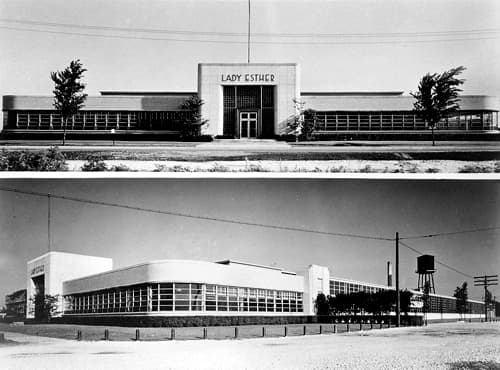
Above: Front and side views of the Lady Esther plant in Clearing, Illinois. The top view shows the main entrance into the administrative building. Architect: Albert Kahn [1869-1942].
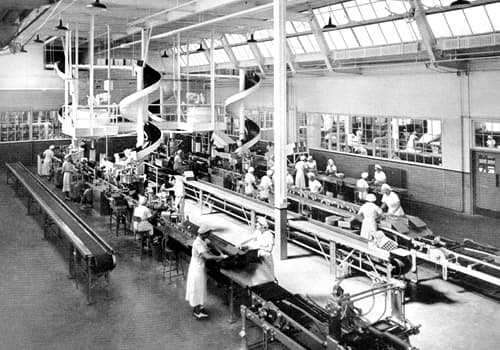
Above: 1938 Face cream assembly line. Manufacturing facilities can be seen though the window at the back and the face powder assembly line can be seen through the window on the right.
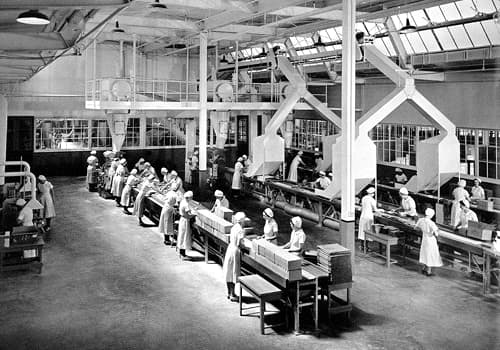
Above: 1938 Face powder assembly line. Manufacturing facilities can be seen though the glass at the back and the storage, loading and shipping room is on the right. Concrete floors and dust extractors keep dust down.

Above: 1938 Enclosed Shipping bay. As with the other rooms, good use is made of natural lighting.
Problems
Unfortunately, the good times did not last. In 1938, a disagreement led to a parting of the ways between Wayne King and Lady Esther with Guy Lombardo [1902-1977] and his Royal Canadians taking over the ‘Lady Esther Serenade’ on CBS. Lady Esther also reduced the amount it spent on radio advertising which it fell from US$461,671 to US$37,104 on NBC between 1939 and 1940, only slightly offset by increased spending on CBS from US$439,875 to US$517,795 in the same period.
Competition was also increasing. The arrival of Coty’s Air-Spun Face Powder in 1935 threatened Lady Esther powder sales. Coty’s ‘Beauty born of a cyclone’ Air-Spun Face Powder campaign was helped, in part, by Coty’s prominent placement in the 1939 World’s Fair. Its success appears to have led Lady Esther to start advertising that its face powder was made with a ‘Twin-Hurricane method’ in 1941.
Lady Esther Face Powder is not mixed or blended in the usual way. It’s blown by TWIN HURRICANES until it’s much smoother, finer, than ordinary powder.
The TWIN-HURRICANE method makes the shades different, too! Just imagine—hurricanes blow the color into this amazing powder! That’s why the shades are so rich and glamorous. That’s why Lady Esther Powder makes your skin look so much fresher, younger.(Lady Esther advertisement, 1942)
See also: Coty “Air Spun” Powder and Coty and the 1939 New York World’s Fair
A more serious competitor to Lady Esther products was the arrival of Max Factor’s Pan-Cake Make-up, released for general use in 1938. This undermined the widespread practice of first applying a face cream then a face powder, particularly with younger women. Lady Esther was the largest seller of face powder to this younger market in the United States, so Pan-Cake and other cake make-ups undermined sales of its face powder. The company responded with advertisements; returning to a familiar theme it warned that cake make-up could clog skin pores.

Above: 1944 Part of a Lady Esther advertisement warning that cake make-up could clog pores particularly on dry skin.
See also: Pan-Cake Make-up
Another problem for Lady Esther in the late 1930s was the Federal Trade Commission (FTC) which questioned many of the claims Lady Esther made for its own and its competitors’ products. By 1941, the FTC had forced the company to agree to cease and desist orders that curbed some of the company’s negative advertising. However, it did not stop Lady Esther completely and the company continued to use negative scare tactics in the 1940s. It also tried to duplicate the success of its ‘bite test’ campaign by introducing other ‘tests’, including the ‘elbow test’ for face powder (1941) and the ‘patch test’ for 4-Purpose Cream (1944). Neither promotion was particularly effective.
Products
Lady Esther Four-Purpose Cream and Lady Esther Face Powder remained company staples right through the 1930s. To help promote the Four-Purpose Cream, Lady Esther packaged it in a new container from the noted industrial designer, Helen Dryden [1882-1972], using a design registered in 1931. I do not know when it went into production but I imagine it was no later than 1933 when the company leased additional manufacturing space in Evanston.
In 1935, the company also repackaged its Lady Esther Face Powder in octagon-shaped boxes, patterned with pastel-blue polka dots, also designed by Dryden. She was also responsible for the plain single-colour, square-shaped rouge boxes in use at the time and may have designed the matching lipstick cases.

Above: Lady Esther Face Powder, Four-Purpose Cream, Compact Rouge, and Lipstick.
In 1940, the octagonal-shaped, face powder boxes were replaced with round, blue boxes, patterned with white fans and pink LE logos, possibly to reduce the cost of packaging as times got tougher. These boxes, or variants of them, would remain in use until the 1960s.
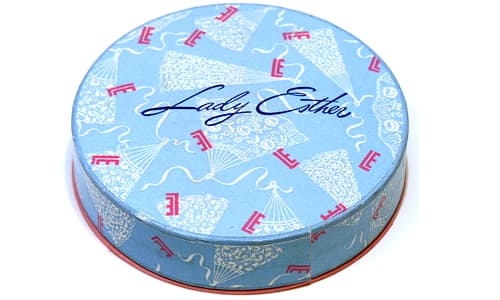
Above: Lady Esther Face Powder box pattern introduced in 1940. The boxes were made by W. C. Ritchie & Co., a Chicago paper box manufacturer first started by Ritchie & Duck in 1866.
Lady Esther also increased the shade range of its face powder during the 1930s. Originally produced in three shades, White, Brunette, and Flesh, this had been increased to five, Dark Brunette, Rachel, Beige, Brunette, and Natural, by 1935, with Daye, Nihte, Sunset, Tawny Rachel, and Mid-Nihte Sun shades added in 1937. Not all of these shades were popular and when the Twin-Hurricane Face Powder was launched in 1941 the shade range was dropped to seven.
The Four-Purpose Cream and Face Powder were meant to be used in combination. As mentioned earlier, this was common practice right up until the Second World War, with most women using a vanishing cream or similar as a powder base to help the powder stick to their skin.
First cleanse your face and neck with Lady Esther 4-Purpose Face Cream. This one cream will leave your skin so clean and smooth that my powder will cling for at least four hours. Then gently smooth on my face powder with a clean cotton puff. Never rub! Hard rubbing always causes wrinkles. Don’t forget your neck! Powder should be applied evenly from the dress line to the hair line. A contrast between your neck and face spoils your whole appearance. Best results are obtained when all make-up is removed with Lady Esther Cream before fresh make-up is applied.
(Lady Esther Face Powder pack directions)
Lady Esther also added some new lines in the 1930s, the first of which was Lady Esther 4-Purpose Hand Cream (1931). The cream also marked the switch from ‘four’ to ‘4’.
4-Purpose Hand Cream: “[I]nstantly beautifies in four ways: 1. It actually whitens the skin 2 to 3 shades while you watch. 2. It softens and smooths, removing the tell-tale shine of dryness. 3. It heals tiny cracks and chapping. 4. It protects the skin with a film so delicate you can’t see or feel it. Rough, wrinkled hands become smooth, white, and young again—in only 2 minutes time!”
A second new product was Lady Esther 7-Day Cream Polish. Liquid nail polish was one of the few cosmetics that experienced sales growth through the 1930s and Lady Esther decided to enter this field in 1938, introducing its nail polish in ten shades. To ensure that customers selected the right shade the company provided them with celluloid colour tips which they could place across their nails to view the effect.
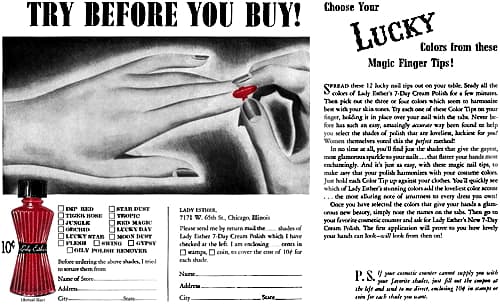
Above: c.1940 Lady Esther Magic Finger Tips.
7-Day Cream Polish: “At last, a cream polish of enduring loveliness . . . a polish that goes on in one smooth coat . . . and stays perfect for as long as 7 days!” Shades: Flame, Flesh, Star Dust, Scarlett, Jungle, Swing, Lucky Rose, Lucky Day, Lucky Star, and Tiger Rose. Later Orchid, and Moon Dust (1939); and Imp Red, and Red Magic (1940).
Many raw materials used in cosmetics became difficult to source during the war. This was particularly so for liquid nail polishes which used nitrocellulose. Lady Esther did not advertise its nail polish during the war and it is possible that it went out of production for the duration.
Mention should be made of two other make-up items, lipstick and rouge, both products having been in production since the 1920s at least.
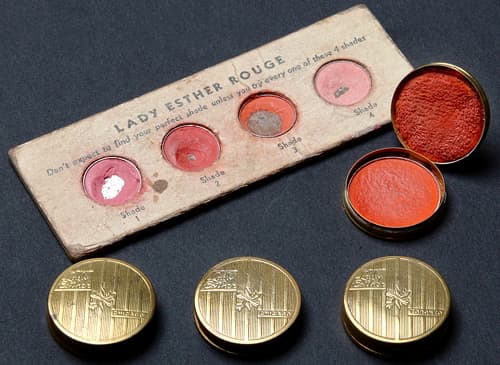
Above: Lady Esther Rouge sample and compacts.
Lady Esther appears to have followed Max Factor and others and numbered the shades of its lipsticks and rouge rather than giving them specific shade names. This may have changed by 1939 by which time both cosmetics were available in six shades.
Lady Esther Rouge: “[R]evolutionary because it introduces a radically new discovery in color. It gives to the cheeks new color which is alive and rich, vibrant and warm-not just a mere spotch of red. When scientifically applied according to the directions, it brings out the flattering tones of skin and eyes and hair.”
Lady Esther Lipstick: “[A] new method of lip make-up. It will beautify your mouth—make it lovely, exciting, tempting.”
Post war
After the war, Syma sold her share of the business to Alfred who then became the company president. Unfortunately, Alfred was not a well man and he died from polycystic kidney disease in 1951. Legal disputes between Syma and Alfred’s heirs ran for a number of year but these were eventually settled with the Cook County Probate Court putting Lady Esther up for auction in 1953.
The auction was won by Chesapeake Industries, a holding company, for US$3,275,000. Eighteen days later Chesapeake sold the shares, land, buildings and machinery of Lady Esther to the Lansing Foundation for the same price. Some of the preferred and common shares were then bought back by Lady Esther Ltd. before the Zonite Products Corporation – a New York Company founded in 1922 – began its acquisition of Lady Esther from Lansing in December, 1953. This was completed in 1954 with Zonite paying US$2,300,000 in cash and 200,000 in common shares and an additional US$861,667 for the land and buildings in Chicago. Lady Esther then became a division within Zonite Products and remained so when Zonite Products changed its name to the Chemway Corporation in 1955.
Products
Lady Esther extended and modernised its product range in the post-war period and Zonite/Chemway continued this process after it competed its purchase of Lady Esther in 1954.
Skin-care
The first new skin-care line added by Lady Esther after the war was Hands-Up (1950). This hand cream was unusual in that it came in four shades which means that it could also be thought of as a type of make-up.
Hands-Up: “A hand makeup that glorifies your hands in exactly 10 seconds. Just smooth it on . . . and while it gives your hand new hand beauty, this superior softening cream gives your hands extra care.” Shades: Peach, Natural, Ivory, and Deep Brunette.
Skin-care products added after Alfred’s death included Lady Esther Estrogenic Hormone Moisture Cream (1953), 4-Purpose Liquid Face Cream (1954), Dry Skin Cream (1957), and Hand and Body Lotion (1961).
The Estrogenic Hormone Moisture Cream (1953) was considered to be beneficial for the face and throat. It was made with natural rather than synthetic estrogens which the company said were made more effective by being mixed into a ‘fast penetrating base’.
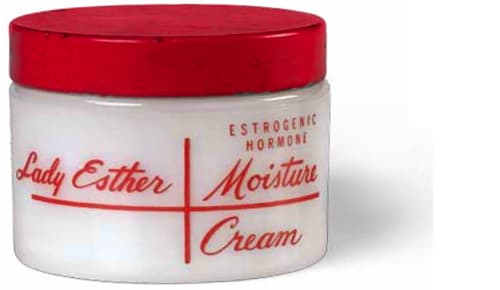
Above: Lady Esther Estrogenic Hormone Moisture Cream.
Estrogenic Hormone Moisture Cream: “You simply smooth it into your face and neck especially over lines and wherever the skin is dry or needs fresh tone. Lady Esther does the rest!”
Lady Esther wisely stayed within the 10,000 International Units (IU) of hormones per ounce stipulated by the American Food and Drug Administration (FDA) so, unlike others, it did not get into any problems with the regulatory authorities.
See also: Hormone Creams, Oils and Serums
As a hormone cream, the product was a very late entry but the cream could also be viewed as an early example of a moisturiser, a market that would become dominant from the 1960s onwards. Unfortunately, the company failed to capitalise early on this emerging trend.
The 4-Purpose Liquid Face Cream (1954) was probably aimed at younger customers. To strengthen the link between this new face cream and the older 4-Purpose Cream, the product was referred to as a liquid cream rather than a lotion and was packaged in the same red colours.
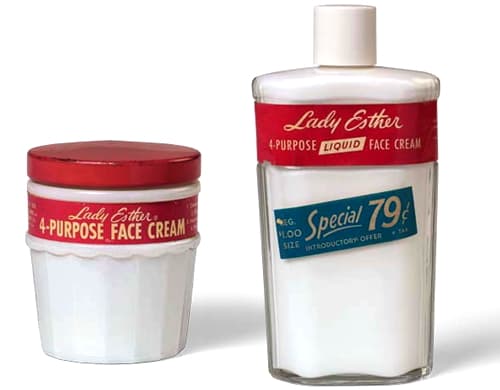
Above: Lady Esther 4-Purpose Face Cream and Liquid Face Cream. A pump-pack dispenser was added by 1957.
4-Purpose Liquid Face Cream: “[G]ently cleans, softens, tones . . . a perfect foundation, too!.”
The Dry Skin Cream (1957) also referenced the 4-Purpose Cream and was sold in a similar jar but used blue labels. However, it marked a move away from the idea that the 4-Purpose Cream could be used on all skin types. In keeping with its history of negative and scare advertising, Lady Esther claimed that the Dry Skin Cream would eliminate ‘Drychosis’, a word the company made up, with the company referring to the sales girls that pushed the cream as ‘Drychiatrists’.
Dry Skin Cream: “[W]ill make that taut, dry feeling disappear in sixty seconds. With penetrating, non-sticky lanolin, moisture-starved skin becomes soft, smooth—looks younger.”
The Hand and Body Lotion (1961) was similar to many other products of this type. It was tinted an aquamarine shade, something done earlier by Revlon with its very successful Aquamarine Lotion (1947).
Hand and Body Lotion: “[I]s a softening influence on wintry skins, heals the hurt of chapped hands, silkens flaky dryness.”
Make-up
Lady Esther had sold lipsticks before 1941 but may have stopped making them for the duration of the war. In 1947, it released its Lipcolors lipstick range, a creamy indelible in seven shades.
Lipcolors: “Here is exciting color on your lips instead of lipstick—plus a heavenly feeling of smoothness and softness your lips will say is new. And, oh, how it stays, dinner will not leave your lips half dressed. That is because this is concentrated color that never, never deserts your lips in patches.” Shades: Stardust, Redder Than, Star Ruby, Crimson Bronze, Bridal Pink, Moondust, and Coy Siren.
One of these shades, Bridal Pink, had been added to Lady Esther Face Powder in 1945. Rather than being produced for an individual complexion shade, it was said to be suitable for four basic colouring types – Blond, Brunet, Brown-Haired and Auburn-Hair, making it an ‘all-purpose’ shade.
IF you’re a Blond, “Bridal Pink” will intensify your blondness, make you look softer, more feminine!
IF you’re a Brunet, with fair skin . . . “Bridal Pink” will intensify the contrast, make you look more romantic!
IF you’re Brown-Haired, with a medium skin . . . “Bridal Pink” will give an exciting lift to your entire appearance!
IF you’re Auburn-Haired, with a pale complexion . . . “Bridal Pink”will wake up your skin, give it life and warmth!(Lady Esther advertisement, 1945)
Lady Esther tried a similar approach with its All Purpose Red lipstick shade, released in 1949. This went even further, promising to be suitable for every complexion type and costume colour.
Flatters every complexion type. Goes with every costume color. Here is an utterly new kind of lipstick a true red that is neither “blue-ish” nor orange. A vibrant, All-Purpose Red that is intensely flattering to every complexion type from honey blonde to darkest brunette . . . and goes with every costume color! This Lady Esther All-Purpose Red Lipstick is made with a new long-lasting base. It won’t desert your lips in patches not even when you are eating! So stop worrying about lipstick shades. Avoid costly “experiments”.
(Lady Esther advertisement, 1950)
In 1949, Lady Esther released Complete Creme Make-up, which the company described as ‘ending the need for foundation and powder’. This was the first coloured foundation Lady Esther had developed and, like Revlon’s Fashion Plate (1947), it was applied with the fingertips rather than the wet sponge used with Max Factor’s Pan-Cake.
Complete Creme Make-up: “It gives your skin flattering jewel-like loveliness in any light. No water—no sponge needed! Just smooth it on with your fingertips. It’s non-drying and non-clogging—allows your pores to “breathe.” So good for your skin, it’s like an 8-hour beauty treatment.” Shades: Moondust, Stardust, New You, Adults Only, and Coy Siren.
Lady Esther also updated the formulation of its face powder on more than one occasion. In 1955, this included the face powder now being ‘whirled in lanolin’. New shades were also added, those that I know of being Malibu Tan (1947), Honey (1953), and Nut Bronze (1956).
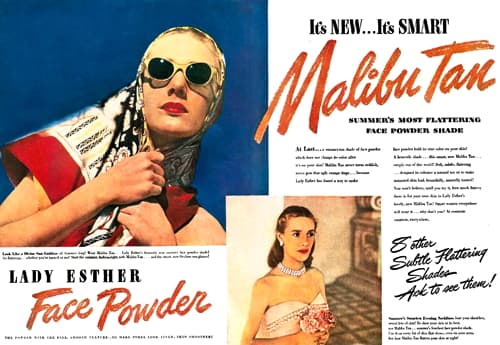
Above: 1947 Malibu Tan.
Later additions to the make-up range after the Zonite purchase included Lady Esther Puff Magic, Sheer Flattery, and Blemish Stick.
Lady Esther Puff Magic (1953) was a pressed powder containing lanolin, so was a good make-up choice for women with dry skin types. It was sold in a faux tortoise shell case with mirror and puff and came in five shades.
Puff Magic: “[C]overs every flaw, yet never cakes or streaks even when you re-powder! That’s because Puff Magic is lightly pressed powder—pressed just enough to prevent it from spilling, but not enough to turn it into a heavy solid cake that gives you a heavy ‘made-up’ look.” Shades: Natural Magic, Honey Fair, Honey Brunette, Bridal Pink, and Tan Magic.
Lady Esther Sheer Flattery (1956) was another creme make-up that came in six ‘skin-harmony’ shades. I imagine it was aimed at the youth market as was the Lady Esther Blemish Stick (1956) which was released in tints that matched specific Lady Esther Face Powder shades.
Sheer Flattery: “[A] new sheerer than sheer, creamier creme make-up that smooths on so easily . . . smooths over every blemish so evenly, you can be absolutely confident that the closer he looks the lovelier you‘ll look.” Shades: New You, Moondust, Coy Siren, Stardust, Adults Only, and Bronze.
Later developments
After 1955, Chemway tried to move Lady Esther away from 5-and-10-cent stores into drug stores and supermarkets. It also added new products and began opening markets for Lady Esther products overseas.
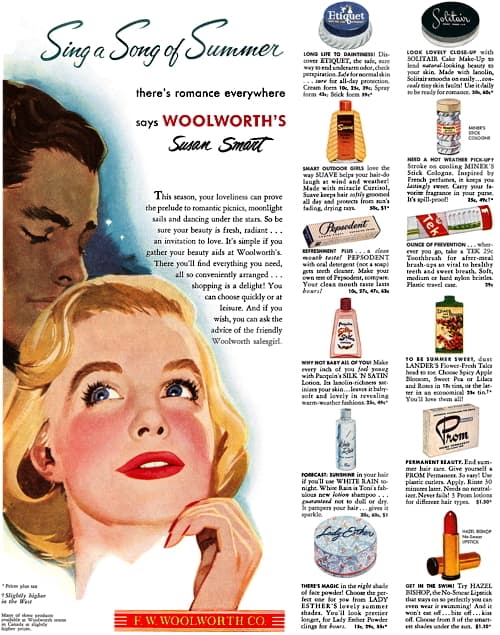
Above:1952 Lady Esther sold through Woolworths.
In 1957, Chemway opened new offices and laboratories in Fairfield Road, Mountain View, Wayne, New Jersey. Chemway was listed as the distributor for Lady Esther so this address then began to appear on Lady Esther packaging. It is also possible that some or all of Lady Esther products were manufactured there as well.
Most of the new products added to the Lady Esther in the 1960s were aimed at the younger women who would be more likley to be shopping in the drug stores and supermarkets where Chemway would like to see Lady Esther becoming more prominent. The Young Lady Esther range therefore wisely included a moisturiser and two make-up items that became increasingly important to the youth market in the 1960s – liquid foundation and eye make-up.
Active Beauty Moisture Creme: “Homogenises into multiple dewy droplets, for quick penetration. A cream that builds the reservoir of moisture.”
Active Beauty Foundation: “Creams into a gossamer veil that spreads uniformly, for an exquisite make-up finish.”
Active Beauty Cleanser: “Floats dirt up from deep down—holds it in suspension, to be tissued away.”
Unfortunately, like many companies, Lady Esther got caught up in the mergers and acquisitions of the 1960s and 1970s which led to a downward spiral in its fortunes. In Lady Esther’s case this started with Chemway being bought by Cooper Laboratories, Inc. in 1970. Cooper bought Chemway for reasons other than Lady Esther and the brand was sold to McKesson & Robbins by 1974. They passed it on to Revlon, probably via Revlon’s purchase of Norcliff Laboratories from McKesson & Robbins in 1975.
Revlon placed Lady Esther into Norcliff Thayer, Inc., a company Revlon created by combining a number of its acquisitions with Norcliff. There it sat for a decade until Revlon was forced to sell Norcliff Thayer to SmithKline Beecham in 1985 after Revlon was taken over by Pantry Pride. SmithKline Beecham did not own it for long, selling Lady Esther and thirty-one other over-the-counter pharmaceutical and toiletry products to Menley & James, Inc. in 1990.
In 1998, Numark Laboratories, a company that bought up depreciated brands, acquired most of the assets and liabilities of Menley & James for US$12.9 million, and then sold the Lady Esther face cream and powder product lines to Lee Pharmaceuticals in the following year for US$$220,000 plus US$169,000 for inventories. Lee Pharmaceuticals appears to be the current holder of Lady Esther in the United States but, as far as I can tell, only the 4-Purpose Cream has been available in recent times and even that may now be out of production.
Overseas things faired a little better. Chemway had trademarked Lady Esther in West Germany in 1961 and following good sales there, created Lady Esther Kosmetik GmbH in Munich in 1966 to promote the line in West Germany and the Common Market. In 1974, Vileda bought Lady Esther Kosmetik and the world-wide trademarks for Lady Esther outside of the United States and then set about expanding the reach of Lady Esther inside the European Common Market. This included an unsuccessful attempt to establish Lady Esther in Britain in 1980.
Unfortunately, Vileda’s hopes for Lady Esther Kosmetik seemed to have been unfulfilled and it sold Lady Esther Kosmetik GmbH to the Figaj family in 1984. They moved the business to Bensheim, built a factory there in 1989 and gave the brand the attention it deserved. Like a number of other American brands that have largely disappeared from their country of origin – such as Harriet Hubbard Ayer and Barbara Gould – Lady Esther lives on in Europe.
Timeline
| 1913 | Lady Esther founded. |
| 1922 | Lady Esther incorporates; and sales begin in Canada. |
| 1923 | Company moves from 441 West Division Street to 5710 Armitage Avenue, Chicago. New Products: Frenchy Face Powder. |
| 1931 | Lady Esther begins radio advertising. New Products: 4-Purpose Hand Cream. |
| 1932 | Lady Esther Inc. renamed as Lady Esther Ltd.; Cosmetics, Inc. founded. |
| 1933 | Additional manufacturing space leased in Evanston, Illinois. |
| 1934 | Packaging, Inc. founded. |
| 1935 | Face powder box repackaged. |
| 1937 | Company moves to Clearing, Chicago. |
| 1938 | New Products: 7-Day Cream Nail Polish. |
| 1940 | Face powder box repackaged. |
| 1947 | New Products: Lipcolors. |
| 1949 | New Products: Complete Creme Make-up. |
| 1950 | New Products: Hands-Up hand cream. |
| 1953 | Lady Esther acquired by Zonite Products. New Products: Estrogenic Hormone Cream; and Puff Magic pressed powder. |
| 1954 | New Products: 4-Purpose Liquid Face Cream. |
| 1955 | Zonite Products becomes the Chemway Corporation. |
| 1956 | New Products: Sheer Flattery cream make-up, and Blemish Stick. |
| 1957 | New Products: Dry Skin Cream. |
| 1966 | Lady Esther Kosmetik GmbH established in Munich, West Germany. |
| 1968 | New Products: Facial Washing Cream. |
| 1970 | Chemway acquired by Cooper Laboratories, Inc. |
| n.d. | Cooper Laboratories sells Lady Esther to McKesson & Robbins, Inc. |
| 1974 | Vileda buys Lady Esther Kosmetik GmbH and the worldwide rights to Lady Esther outside the U.S.A. |
| 1975 | Norcliff Laboratories bought from McKesson & Robbins by Revlon. |
| 1980 | Lady Esther becomes available in Britain. |
| 1984 | Lady Esther Kosmetik GmbH sold to the Figaj family who move the company to Bensheim, Germany. |
| 1985 | Revlon sells Norcliff Thayer to SmithKline Beecham. |
| 1989 | Lady Esther Kosmetik GmbH builds a factory in Bensheim. |
| 1990 | SmithKline Beecham sells American Lady Esther and others to Menley & James, Inc. |
| 1998 | Numark Laboratories, Inc. buys the assets of Menley & James. |
| 1999 | Numark Laboratories sells American Lady Esther to Lee Pharmaceuticals. |
First Posted: 16th May 2020
Last Update: 15th January 2023
Sources
The American perfumer & essential oil review. (1906-1955). New York: Robbins Perfumer Co. [etc.].
The chemist and druggist. (1859-) London: Morgan Brothers.
Lady Esther Kosmetik GmbH.
Lady Esther, Ltd. v. Lady Esther Corset Shoppe, 317 Ill. App. 451, 46 N.E.2d 165, 148 A.L.R. 6 (1943).
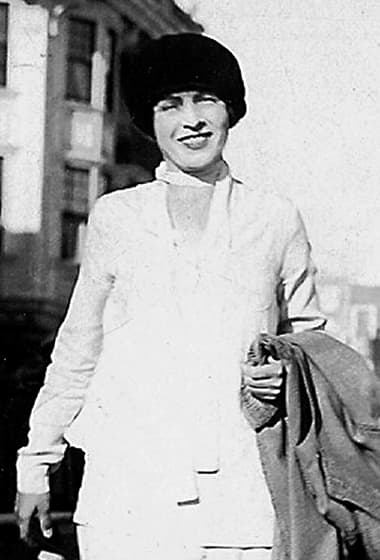
Syma Cohen a.k.a. Syma Busiel [1891-1990].

1922 Lady Esther Four-Purpose Cream.
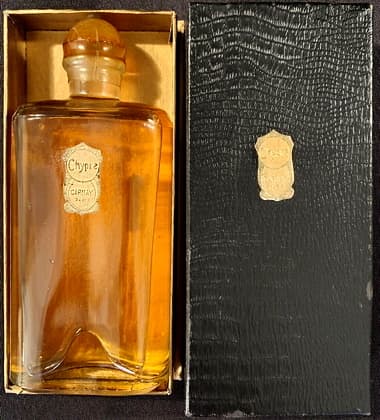
Lady Esther Chypre Toilet Water.
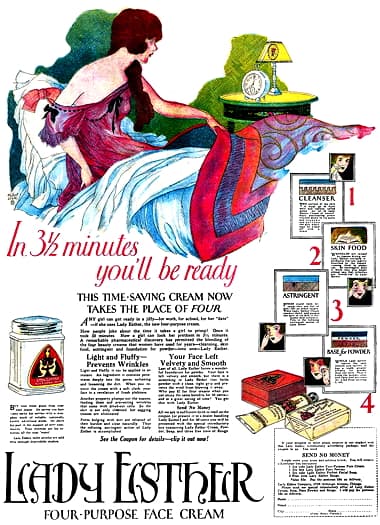
1923 Lady Esther Four-Purpose Face Cream.
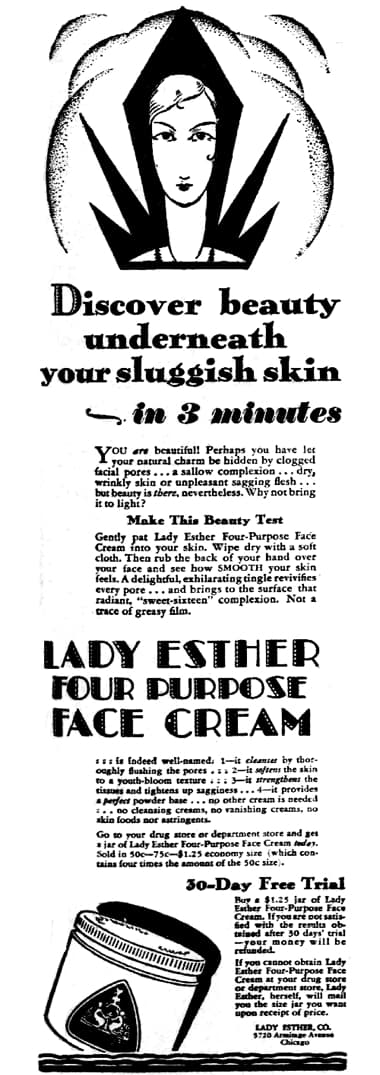
1929 Lady Esther Four-Purpose Face Cream.
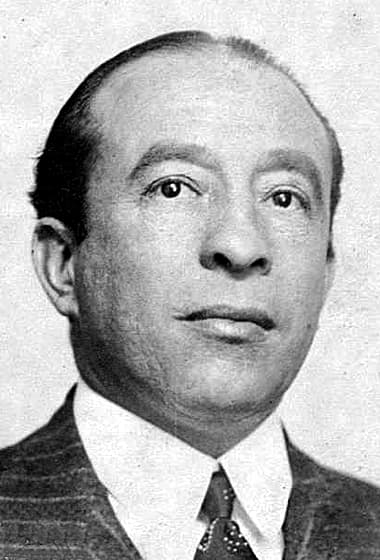
Alfred Hamilton Busiel [1901-1951].
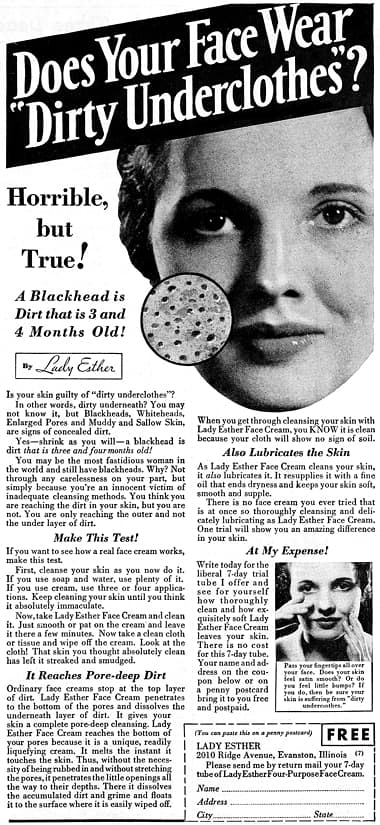
1934 Lady Esther Four-Purpose Face Cream.
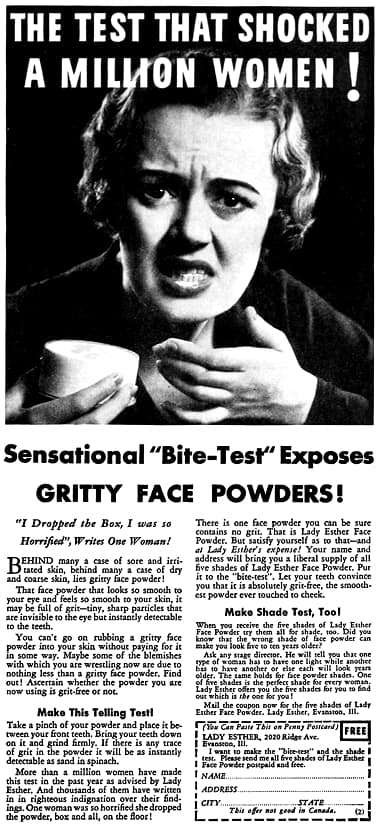
1934 Lady Esther Bite Test.
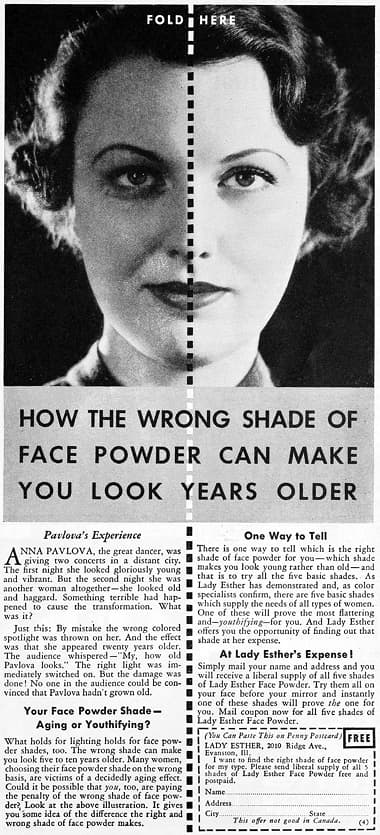
1934 Lady Esther Face Powder.
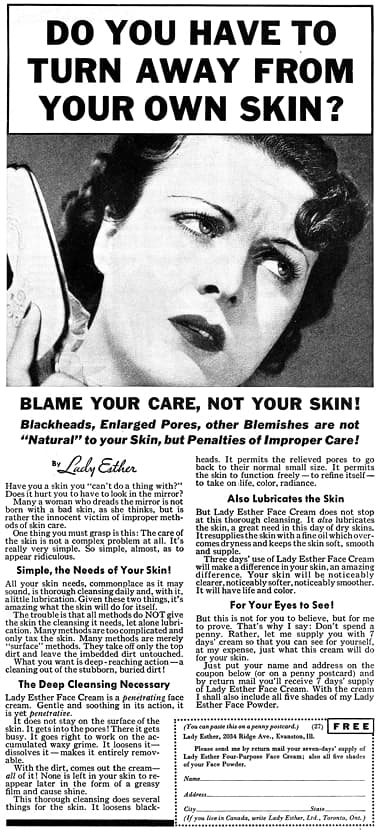
1936 Lady Esther Four-Purpose Face Cream.
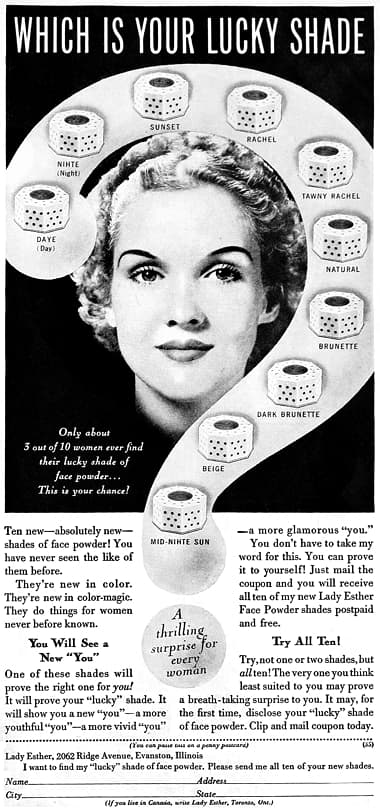
1937 Lady Esther Face Powder in 10 shades.
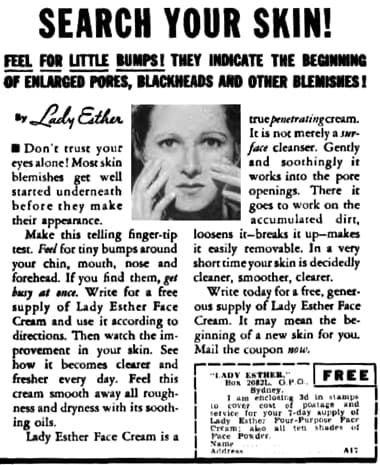
1938 Lady Esther (Australia).
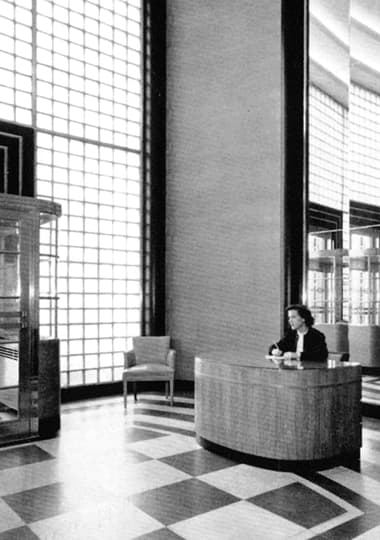
1938 Reception in the administrative building in Clearing, Illinois.Glass bricks are used to make the entrance stand out and give the room light.
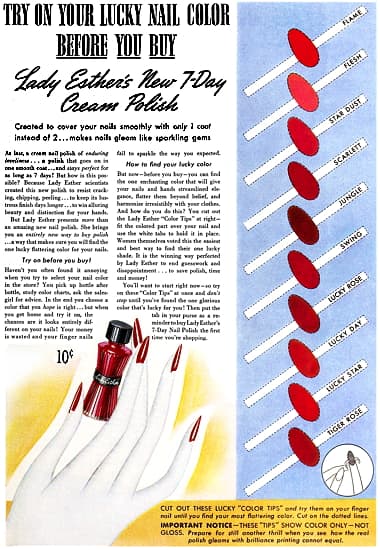
1938 Lady Esther 7-Day Nail Polish.

1940 Lady Esther Rouge (The Philippines).
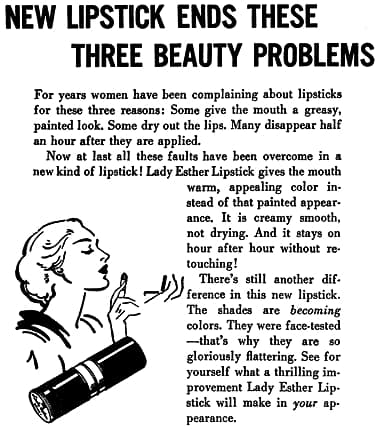
1940 Lady Esther Lipstick (The Philippines).
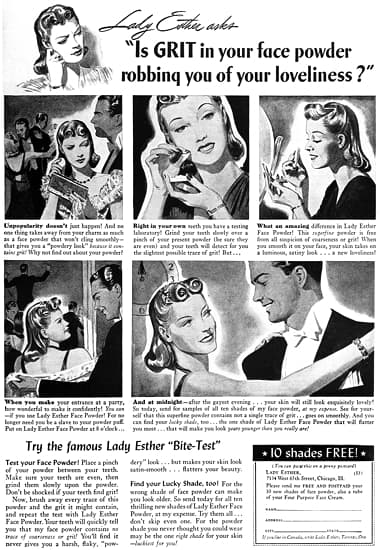
1940 Lady Esther ‘Grit Test’.
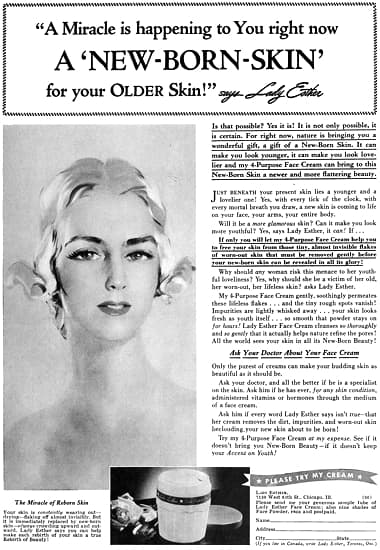
1940 Lady Esther 4-Purpose Cream.
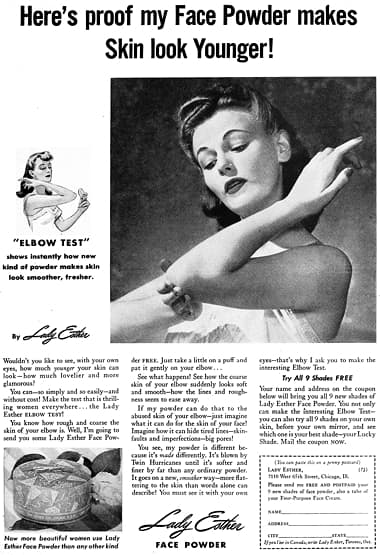
1941 Lady Esther Elbow Test.
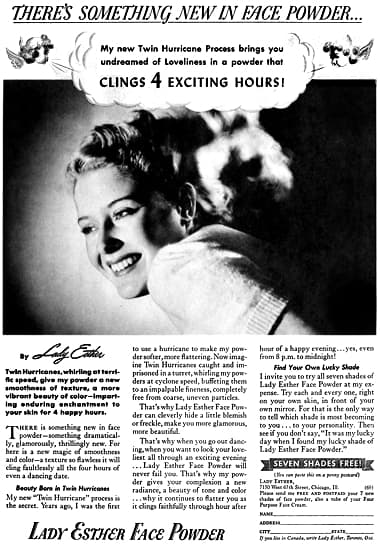
1941 Lady Esther Twin-Hurricane Method Face Powder.
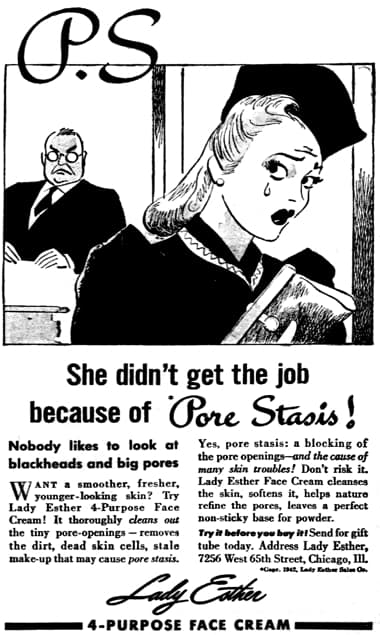
1942 Lady Esther ‘Pore Stasis’.

1944 Lady Esther Face Powder. Cake make-up warning.
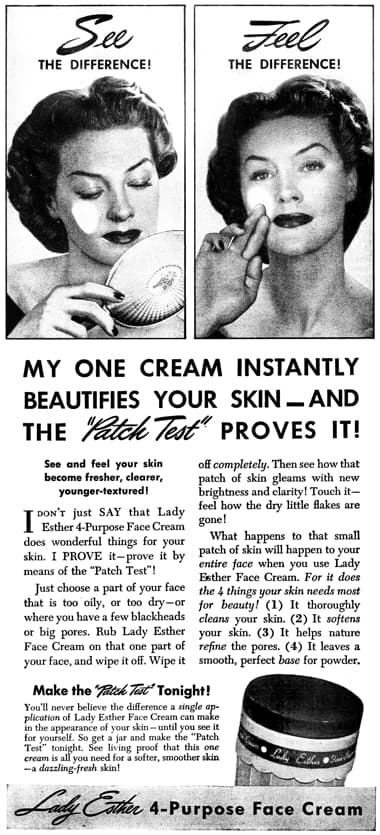
1944 Lady Esther Patch Test.
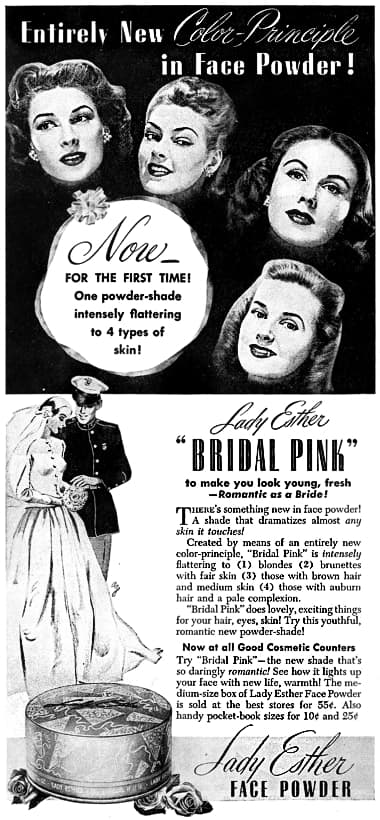
1945 Lady Esther Bridal Pink.

1947 Lady Esther 4-Purpose Face Cream.
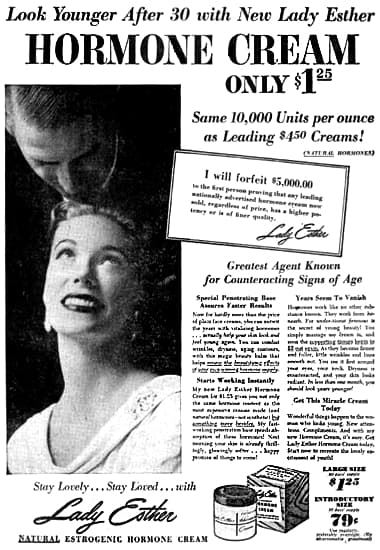
1953 Lady Esther Estrogenic Hormone Moisture Cream.
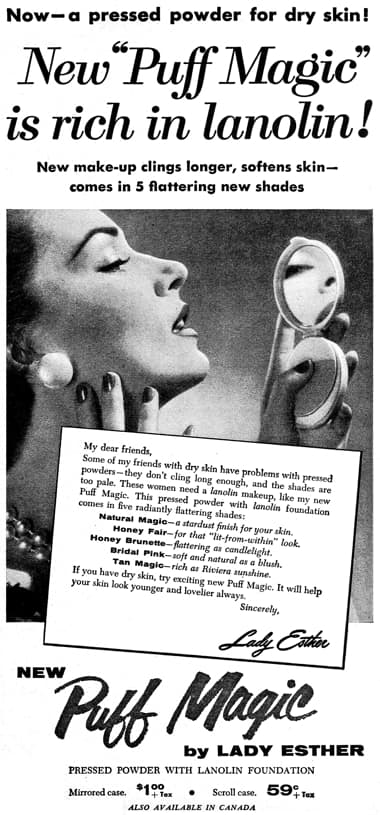
1954 Lady Esther Puff Magic.
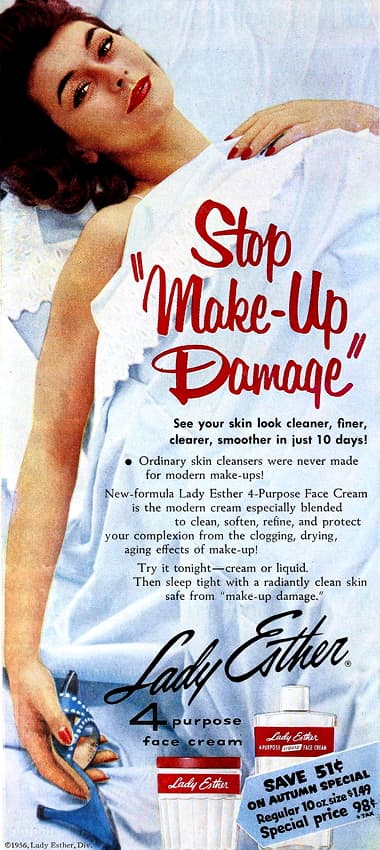
1956 Lady Esther 4-Purpose Face Cream and Liquid Face Cream.
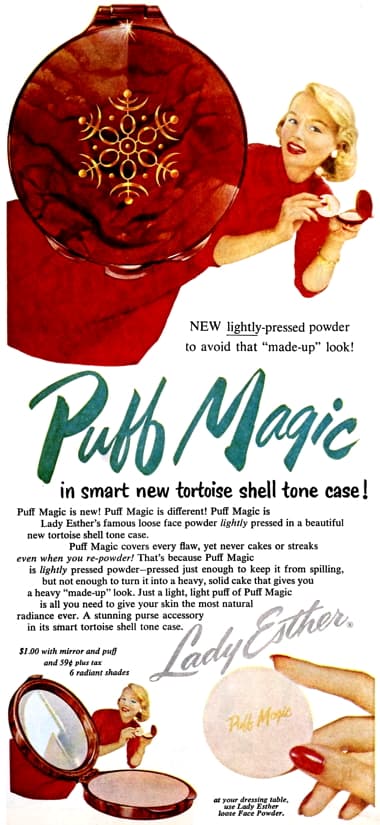
1956 Lady Esther Puff Magic.
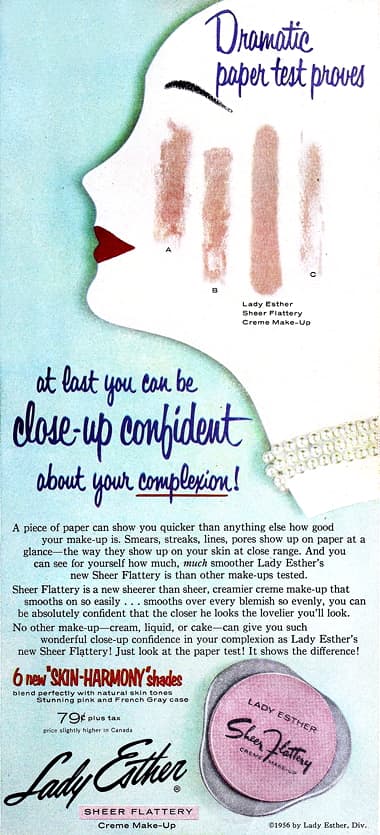
1956 Lady Esther Sheer Flattery.

Lady Esther Dry Skin Cream.

1958 Lady Esther Dry Skin Cream.

1964 Young Lady Esther Active Beauty.
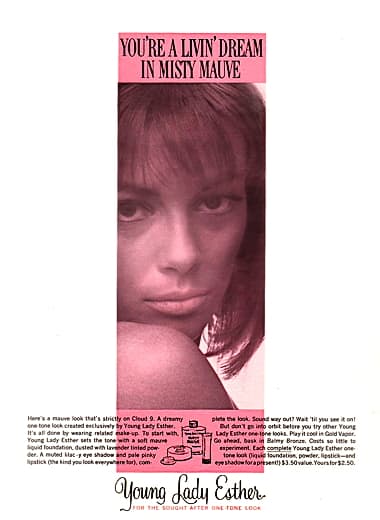
1964 Young Lady Esther.
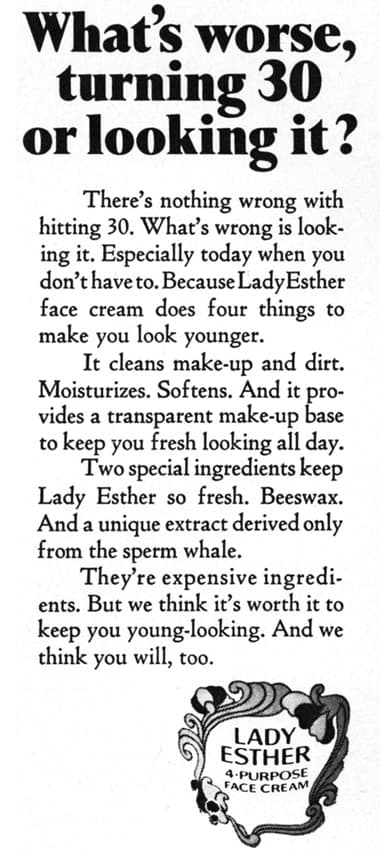
1970 Lady Esther 4-Purpose Face Cream. Made with spermaceti, I assume this was later replaced with an alternative source of cetyl alcohol.
